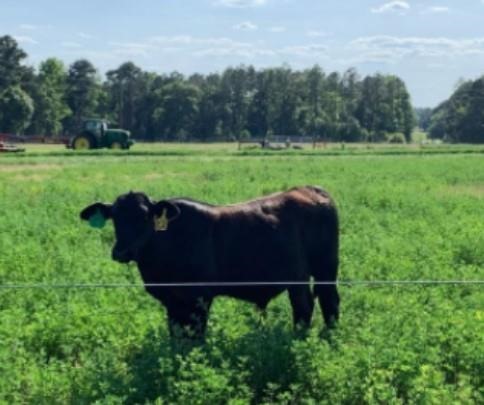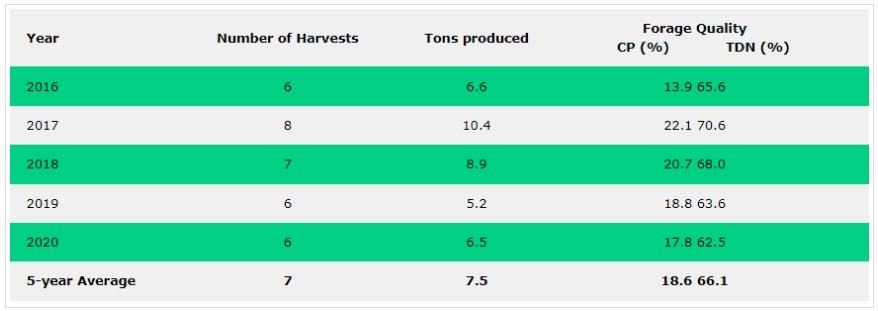By Jeremy Kichler
Bermudagrass is a dominant perennial warm-season grass that accounts for more than 20 million acres of pastures and hayfields across the Southern U.S. While this high yielding forage serves as an excellent perennial base for many ruminant diets in Georgia it does have it’s limitations. Bermudagrass requires high-fertility inputs including several applications of Nitrogen to meet yield potential, it’s growth distribution is limited to the hot humid summer months, and forage nutritional value of bermudagrass monocultures is typically moderate at best. However, the addition of a legume species like alfalfa can enhance the bermudagrass monoculture and improve livestock-forage system utilization, quality, and yield while also serving as a wildlife and pollinator habitat.

MYTH: Alfalfa? That won’t grow here!
If I had a penny for every time I’ve heard that Alfalfa won’t grow in Georgia, I’d be rich! However, the reality is Alfalfa can and will successfully grow in the Deep South and is an excellent option for interseeding into bermudagrass stands. Alfalfa and bermudagrass have several similarities when evaluating establishment and management practices and recommendations. Both forages require fertile well-drained soils and will not survive in areas of excessive wetness. Both are susceptible to insect pressures that must be monitored and controlled for greatest stand performance. Most interestingly, when looking at fertility recommendations for both alfalfa and bermudagrass side-by-side, the nutrient requirements are nearly identical with the exception of the high N recommendation for bermudagrass. Thus, the combination of alfalfa and bermudagrass is a great fit and is a viable option for forage and livestock producers in the region.
FACT: Alfalfa-Bermudagrass Mixtures Provide High-Quality Forage for Beef Cattle
Alfalfa-bermudagrass mixtures can be effectively managed as either a stored forage option (i.e. hay or baleage) or in a grazing system (when utilizing dual-use hay and grazing varieties). Alfalfa-bermudagrass mixtures are a great option for producers that are looking for alternative ways to improve forage intake, diet nutritional value, and animal performance while decreasing outside feed supplementation. Recent research from the UGA Tifton Campus Beef Unit evaluated the yield and quality of ‘Bulldog 805’ alfalfa interseeded into ‘Tifton 85’ bermudagrass and harvested as a high-moisture feed source for 5 years. Results from this project are presented in Table 1.
Table 1. Number of harvests, tonnage, and quality of Alfalfa-Bermudagrass mixtures produced as baleage (UGA Tifton Campus Beef Unit)

While the addition of alfalfa to bermudagrass provides increased forage quality across the growing season, the spring and fall cuttings consistently report the highest nutritional values. This is due in part to the ebb and flow relationship experienced with the complimentary growth curves of the two forages. The alfalfa component provides greatest contribution in the early spring and fall but can undergo a summer slump during the hottest times of the year. Alternatively, the bermudagrass component is strongest during the hot summer months and thus provides greater stand contribution in July and August.
FACT: Alfalfa-Bermudagrass Mixtures Can Be Grazed with Proper Management.
Grazing of alfalfa-bermudagrass mixtures is a viable option when successfully managed using a rotational grazing system or in a creep grazing scenario. With proper rotation and rest these mixtures have the potential to provide grazeable forage from spring through fall, and even as a possible early stockpile option. A two-year grazing evaluation at the UGA-Tifton Campus Beef Unit determined that while adding alfalfa to bermudagrass did not show significant increases in steer average daily gain (ADG), the mixture did result in increased gain/acre, stocking rate, and average seasonal gain in comparison to bermudagrass monoculture. Additionally, this project highlighted the need for refined grazing management recommendations to optimize mixture performance thus a tri-state research evaluation was implemented in Georgia, Alabama, and Florida. This project determined stand performance in relation to yield, quality, and alfalfa persistence were optimized when mixtures were harvested no sooner than 4 weeks and no shorter than 4 inches. On-going research at the UGA Tifton Campus Better Grazing Program and Auburn University Wiregrass Research and Extension Center are putting this recommendation into practice in a multi-use project that simultaneously evaluates harvest methodologies for alfalfa-bermudagrass mixtures across the growing season using either a mechanical harvest (cutting as hay or baleage), harvest through grazing (rotational grazing on a 7 day graze 28 day rest interval), or dual use (Hay and grazing) system.
Preliminary best management practice in a dual-use system suggests harvesting or grazing alfalfa-bermudagrass mixtures in the spring, allowing for rest and/or a delayed harvest (~35 days) in the summer, and returning to grazing in the fall as final harvest before winter rest. By harvesting the spring cuttings (March-May) as stored forage producers will have a high-quality alfalfa dominant forage option to feed during periods of low forage availability or harsh weather conditions. This also allows producers the option of matching the animal needs to the forage quality, strategically feeding the highest quality forage to highest need based on stage of production.
FACT: Benefits to Beef Cattle Outweigh the Risks.
While there are some challenges when growing and managing grass-legume mixtures, the benefits of alfalfa-bermudagrass forage systems may be worth the risk. Our research has consistently shown that adding alfalfa to bermudagrass increases seasonal yield potential, nutritive value, and extends the use of a single unit of land when compared to a bermudagrass monoculture system. In addition, the legume-grass mixture provides diversity in diet and ecosystem, decreases reliance on external commercial Nitrogen applications, and provides potential grazeable forage for much of the year. Finally, the addition of alfalfa to existing warm-season sods provides beef producers with a back-up plan if alfalfa establishment fails or stand persistence is limited. In this particular system, even in the instance of an alfalfa stand failure, the perennial grass base remains thus decreasing the chance of a field being unusable for an entire season. With proper preparation and overseeding of bermudagrass with alfalfa in the fall, producers can expect to be utilizing the mixture by late Spring of the first year, after alfalfa has reached a 25% bloom stage. Rather than requiring extended down time, the alfalfa addition allows for earlier use than the warm-season sod alone even in the first year!
*Funding for projects mentioned provided by Georgia Beef Cattle Commodity Commission and USDA NIFA Alfalfa Forage Research Program
Source : uga.edu